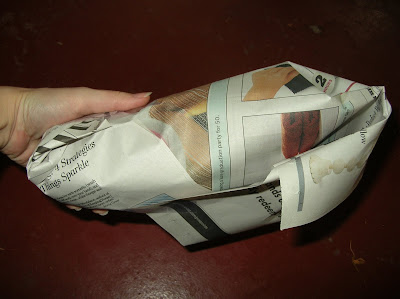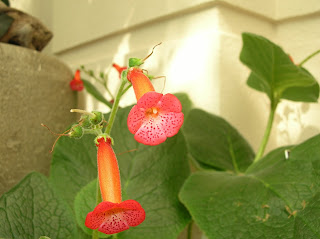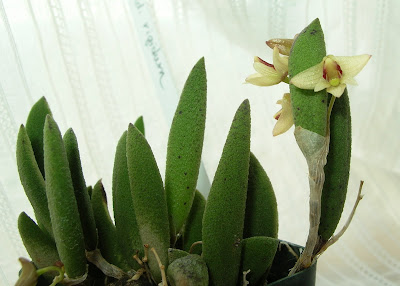Plant Sales Live on JuliaRedman.com
One of the most common questions I get, after "how do I grow this" of course, is about how I ship plants. I've been shipping and receiving plants through the mail for so long, I forget that there are many people out there for which this is a new concept. But its actually rather straightforward. The first step in hot weather is to water the plant, generally the night before packing, to reduce stress during transit. In winter when it is cold I usually prefer to ship the plant dry, to avoid clammy, cold roots. Spring/autumn can go either way. Exception: in winter when it will be below 30F both here and at the destination I generally do not ship. Some growers do ship during such conditions with either the aid of a 60hr heat pack or overnight shipping.Next is to arrange some newsprint or glossy ads on top of the pot and tape or rubber band it down. This will keep the media and plant secure in the pot. 
 Then the plant is wrapped in newspaper. I usually use two sheets or one sheet folded in half for smaller plants, and set the plant on the diagonal. The sheet is wrapped securely around the pot, and then the upper portion of the plant makes a stiff, triangular package the protect the foliage.
Then the plant is wrapped in newspaper. I usually use two sheets or one sheet folded in half for smaller plants, and set the plant on the diagonal. The sheet is wrapped securely around the pot, and then the upper portion of the plant makes a stiff, triangular package the protect the foliage. Finally the plant is set into the box and secured with packing peanuts (and before anyone gets unhappy about my use of packing peanuts, they're always reused ones from other packages!) or more newspaper. The plant is shipped by priority mail, clearly marked as perishable.
Finally the plant is set into the box and secured with packing peanuts (and before anyone gets unhappy about my use of packing peanuts, they're always reused ones from other packages!) or more newspaper. The plant is shipped by priority mail, clearly marked as perishable. Other details to consider: Certain plants cannot be shipped to certain states due to USDA regulations aimed toward protecting local agricultural cash crops and/or protecting the local ecosystem from invasive species. Your local USDA extension office should be able to provide you with a list of restricted items. Shipping plants outside of the USA also entails extra paperwork, I believe, so I don't do it.Other types of plants may require other packing systems, and plants in bloom may require more creative stabilization to protect the flowering stem.I've seen African Violets, for example, shipped nicely by dropping the plant into a plastic drinking cup (after securing the plant in the pot of course) and sticking one or two short bamboo skewers through one edge of the cup to keep the plant inside. This prevents crushing of the foliage, which can be a big problem with mature African violets. Be creative, but avoid packing so securely that the recipient gets trapped by a tape octopus trying to get the plant back out.
Other details to consider: Certain plants cannot be shipped to certain states due to USDA regulations aimed toward protecting local agricultural cash crops and/or protecting the local ecosystem from invasive species. Your local USDA extension office should be able to provide you with a list of restricted items. Shipping plants outside of the USA also entails extra paperwork, I believe, so I don't do it.Other types of plants may require other packing systems, and plants in bloom may require more creative stabilization to protect the flowering stem.I've seen African Violets, for example, shipped nicely by dropping the plant into a plastic drinking cup (after securing the plant in the pot of course) and sticking one or two short bamboo skewers through one edge of the cup to keep the plant inside. This prevents crushing of the foliage, which can be a big problem with mature African violets. Be creative, but avoid packing so securely that the recipient gets trapped by a tape octopus trying to get the plant back out.
 Friday I lingered at work, quietly making use of the tissue culture hood for some clandestine seed sowing. (makes it sound spicy, doesn't it, like James Bond was involved) In actuality, I'm almost always there late, and doing my seed sowing late on Friday means I'm neither in anyone's way nor taking up valuable time I could be using to dissect genomes.
Friday I lingered at work, quietly making use of the tissue culture hood for some clandestine seed sowing. (makes it sound spicy, doesn't it, like James Bond was involved) In actuality, I'm almost always there late, and doing my seed sowing late on Friday means I'm neither in anyone's way nor taking up valuable time I could be using to dissect genomes.
Today I split open and sowed Paph (Hsinying Alien x wardii), a cross I made mostly for awesome foliage. The seeds were a lovely dark brown and rather large on the orchid seed scale. There were a good number that looked viable. Hopefully they'll germinate.
While struggling to get them out of the pod and into a tube for sterilization, I once again had that realization that they look like dust or lint. They act like it, too. They fly every which way, get stuck on paper, stick to the inside of the tubes by static. This, combined with losses stuck to tubes, pipettes, and lost in washes during sterilization can result in loss of what seems like a third to a half of the seed. In actuality, I'm not going to count and find out, even if I should by some miracle catch them all.
The photo attached is of a set of seeds which were sown late spring/early summer (Lc. Green Veil 'Dressy' x Sc. June Bug 'Venice Sunshine'). This bunch was actually rather well behaved, perhaps because I split the pod when it was still green. The little pile of seeds in the bottom left were sown on three plates, one of which was contaminated. The remaining two are now covered with protocorms. The rest of the seed is in storage.
Also today I split open a pod from a Nobile dendrobium x Dend tetragonum, made for "what ifs". The pod had developed very nicely. Unfortunately, it produced no seed.
 Last week my plant cruising buddy, The Larry, and I went downtown to the US Botanical Gardens. A lovely place to visit if you are ever in the area. I go there at least once per year with Larry, and we ogle all our favorites and whatever is new, and engage in nerdy plant discussions.
Last week my plant cruising buddy, The Larry, and I went downtown to the US Botanical Gardens. A lovely place to visit if you are ever in the area. I go there at least once per year with Larry, and we ogle all our favorites and whatever is new, and engage in nerdy plant discussions.
Every time I'm there I lust after their staghorn ferns. I do the same thing at Longwood Gardens. The fine, imposing specimen here is Platycerium willinckii. I absolutely love staghorn ferns, but though I can keep them alive they have never flourished for me. In all likelihood I don't water enough. We also admired their nicely grown specimen of Zelenkoa onustum, a.k.a. Oncidium onustum. Yes, that's right, its mounted on a live cactus. This is a species I like to mention to people who are convinced all orchids live in the tropical rain forests. The fact is, there are orchid species from all kinds of environments - warm to cold, wet to dry, temperate to tropical. As you might guess, this one comes from the deserts of Ecuador and Peru, where it grows in full, blazing sun. If you ever get one, make sure you respect that or it will rot clean away!
We also admired their nicely grown specimen of Zelenkoa onustum, a.k.a. Oncidium onustum. Yes, that's right, its mounted on a live cactus. This is a species I like to mention to people who are convinced all orchids live in the tropical rain forests. The fact is, there are orchid species from all kinds of environments - warm to cold, wet to dry, temperate to tropical. As you might guess, this one comes from the deserts of Ecuador and Peru, where it grows in full, blazing sun. If you ever get one, make sure you respect that or it will rot clean away!
 They always have a little corner with Gesneriads, as well. These are Sinningia eumorpha (top) and lineata (bottom). You may be more familiar with the family through the 'florist' gloxinia and African Violets, but the more obscure species are also quite rewarding to grow. For more information on Sinningias and other Gesneriads, you can get started with this site.
They always have a little corner with Gesneriads, as well. These are Sinningia eumorpha (top) and lineata (bottom). You may be more familiar with the family through the 'florist' gloxinia and African Violets, but the more obscure species are also quite rewarding to grow. For more information on Sinningias and other Gesneriads, you can get started with this site.
 I know I already posted a closeup photo of Dend. rigidum flowers, but I realized today that I should have also posted a photo of the very unique foliage. So since the plants are in bloom again (which they do intermittently throughout the year it seems) I took a few new shap shots. Here it is in all its pebbly, succulent glory.
I know I already posted a closeup photo of Dend. rigidum flowers, but I realized today that I should have also posted a photo of the very unique foliage. So since the plants are in bloom again (which they do intermittently throughout the year it seems) I took a few new shap shots. Here it is in all its pebbly, succulent glory.
